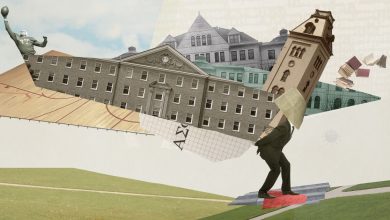The Faculty Job (Almost) No One Wants

Dawson, who chairs the biology department at Kingsborough Community College, had kept an eye on news from around the world before Kingsborough’s spring term began in the first week of March 2020. As a scientist, she was trained to think in terms of potential outcomes, and she instructed her faculty to be ready to move their classes online at a moment’s notice.
So when the call came from the City University of New York system to switch to virtual learning, Dawson and her colleagues were ready. It was, in Dawson’s words, a “seamless” transition for her department.
But a few weeks later, two of Dawson’s adjunct faculty members realized they weren’t up for teaching online and quit. That meant Dawson took on their courses; she wasn’t about to ask her other faculty members to take on extra teaching amid a burgeoning pandemic. That semester, Dawson taught 14 contact hours and worked six days a week, for 12 to 15 hours each day, all while keeping the department running and helping manage her colleagues’ anxiety — something that she, even with several years as department chair under her belt, hadn’t anticipated.
The pandemic, Dawson soon realized, fundamentally changed what it meant to be a department chair, already a job known for being demanding and, in many circles, undesirable.
Chairing a department has never been easy. Doing so means occupying a strange in-between position in academe — not quite an administrator, nor only a faculty member — and navigating a complex set of workplace dynamics, particularly with department colleagues whom a chair, for the duration of her term, is asked to supervise and evaluate.
The chair’s position is often assumed to come with a measure of power and prestige; upon landing the gig, Sandra Oh’s character in the Netflix limited series The Chair proudly places a nameplate on her desk declaring her the one “in charge,” embellished with a handful of expletives. But upon taking over as chair — which, as many will attest, does not often include the cushy office Oh’s character inherits — scholars are more likely to find themselves hemmed in by administrative constraints and what they call an illusion of power.
“As a chair, you certainly have more institutional responsibility than most of your colleagues. You have some authority, although not very much. In most systems, you really don’t have any power at all,” said Kevin J.H. Dettmar, a veteran department chair who is writing a book about the job. “You’re the fall guy or gal; you’re responsible. But in terms of power, prestige? No, not really.”
Instead, the chair is often caught in the crosshairs of conflict between faculty members or administrators, struggling to stake a claim in both worlds.
Ouellette, an associate professor, had seen other chairs struggle with exhaustion and with keeping their own scholarship current. Because she wasn’t yet eligible for promotion to full professor, she worried that the administrative responsibilities of being chair would interfere with her own professional goals.

Nicolas Ogonosky for The Chronicle
Indeed, 86 percent of chairs reported in a 2004 study that they’d significantly reduced their scholarly activities while in the role, and 88 percent said they were frustrated by their inability to spend much time pursuing their academic interests.
Ouellette took four meetings with her provost, who was supportive of her personal goals, before agreeing to the gig, but said, “it’s understood that you can’t really say no. I think I was a little stubborn.”
It stands to reason, then, that colleagues “are as likely to say condolences” as they are to congratulate incoming chairs on their new role. So said Carolyn Dever, who co-facilitates The Chronicle’s workshops for department chairs. “It’s more of a duty than it is a calling for many people,” Dever said. “They’re sandwiched between the administration and the faculty and students without very many tools for solving problems and addressing the really complex issues that come up.”
That’s another condition of being chair: It’s likely to come with little in the way of training. A 2016 study found that 67 percent of chairs hadn’t received any formal training from their institution; two-thirds of those that did said it didn’t adequately prepare them for the job. Nor are there many handbooks on how to be an effective chair; the few there are tend toward the wonky side, said Dettmar, who hopes his forthcoming book will fill that gap.
Ouellette’s preparation for becoming chair, then, was mostly “self-imposed.” “Honestly,” she said, “the first thing I did was Google ‘how to be a department chair.’”
Most of Ouellette’s prior understanding of what it meant to be a chair came from graduate school, where, she said, “it was really communicated pretty clearly, ‘Have some empathy, don’t bother the department chair.’ So I assumed as a graduate student that this was a stressful and perhaps exhausting position.”
Ouellette started to think of a chair’s role as that of an ambassador — of the institution, of the department, and, in her case as a historian, of the humanities. Student and faculty recruitment would become part of her job, as would advocating at the administrative level for her department. Still, she recognized her place within the college’s power structure was a complicated one.
“Sometimes chairs think that what they have is power and authority,” Ouellette said. “I think that I have obligations.” As a chair, she learned, people could look to her for guidance. But Muhlenberg’s faculty handbook didn’t endow her with the ability to add teaching lines, hire or fire faculty members, or adjust the budget. At institutions like hers, she said, “department chairs don’t have a lot of leverage. They can advocate, they can cajole, they can bring people together. But we don’t have the capacity and we are not embedded with any authority to make institutional changes.”
Then came the pandemic. Ouellette did her best to maintain social ties within the department by setting up a weekly social Zoom session for her junior colleagues. She stressed flexible work policies, knowing many of her coworkers had young children at home. She worked to make sure students were supported and oversaw the sudden retirement of a faculty member who decided Zoom teaching wasn’t for them. And she became tethered to her phone.
“There were moments there where my job changed dramatically before my eyes,” she recalled, “and my phone became like a third eye or a third hand.”
Dawson, at Kingsborough, felt similarly tethered to work, partially out of an obligation to be reachable any time her faculty needed her. That was uncharacteristic for Dawson, who is “very much a boundaries person” and customarily doesn’t email her colleagues in the evenings or on weekends. No more: “I had to sort of put that aside and say, ‘You know what, I need to be available to these people, because this is an unprecedented situation.’” Her role, as she saw it, was to field panicked calls and emails with an eye toward resolution. “We can fix this,” became a common refrain, she said, even if “sometimes I had to lie; I wasn’t even sure if we could, but I said we could.”
Then there was the matter of classes themselves. In April 2020, Dawson had to plan course offerings for the fall semester without knowing what path the pandemic would take. The lab spaces in her biology department were booked during every available time frame of the academic day, meaning she couldn’t open up extra sections in order to reduce class sizes and allow students to socially distance. Not normally one to question her decisions, Dawson agonized over this one for months. “All summer, every day, I thought about this multiple times a day,” she said. Ultimately, many classes that planned to meet face to face in the fall had to go on pause for several weeks while social-distancing arrangements were made, or revert online entirely.
Department chairs still face those sorts of conundrums daily. Some have also been put in uncomfortable positions as they enforce institutional decisions, like whether faculty members have to teach in person, Dever said.
“They may profoundly disagree, but they’re in the role of having to carry out whatever it is that the institution has decided. What makes the pandemic much more challenging than regular life,” she said, “is that it’s people’s health and safety that’s on the line, and people’s educations, and so a chair has to live with the high, high stakes of a decision every day.”
In a pair of studies conducted during the pandemic, in 2020 and 2021, by Ralph A. Gigliotti, the assistant vice president for Rutgers University’s Office of University Strategy, many department chairs at Big Ten colleges said the job straddled the line between faculty member and administrator more than ever. All that turmoil is having a clear, and alarming, effect on chairs: Just 22 percent agreed or strongly agreed that they would be more likely than not to serve another term.
He knows the liminal place between faculty and administration that chairs occupy all too well. His first job as chair was at a unionized campus; as a chair, he wasn’t included in the faculty bargaining unit. Dettmar paid union dues anyway, because he wanted to demonstrate to his colleagues that he saw himself as a faculty member. Still, he got mixed messages. “I felt like the faculty don’t think of me as a faculty member, but the administration’s really clear that I’m not really an administrator,” he said. “I didn’t have any natural allies.”
Nothing in Dettmar’s graduate training — which focused on individual scholarly growth and not building community — taught him to value chairing. He heard some say, “Those who can, do; those who can’t, chair.” The idea that a faculty member could be “relegated to a bureaucrat because you’re not one of the leading lights of your generation” was, he felt, both pervasive and damaging.
After 10 nonconsecutive years running the English department, Dettmar began directing Pomona’s Humanities Center instead, thinking his days leading departments were over. But when the dean called in July 2021 to ask Dettmar if he would consider filling in as chair for the theater department, which was dealing with personnel changes, the answer was yes.
“Chair can be something that you are or something that you do. And 95 percent of chairs, it’s something that they do,” Dettmar said. He falls into the small group that consider chairing part of their identity.
He said that’s because he’s good at it, and because he can use it to help others. He’s crossed off all of the brass rings of academe — gotten tenure, been promoted to full professor, been a named chair.
“Instead of writing another scholarly book that 17 people would read,” he said, “I’d rather put my energy into helping a younger generation of scholars be able to write their books.”
While the specifics vary by institution, most chairs receive a course release, a stipend, or some combination of the two in exchange for their service. Sometimes other perks, like an extended sabbatical or extra research funding, can be negotiated. But by and large, those affordances “aren’t commensurate with the demands of the job,” Dever said.
They are, perhaps, even less so for younger scholars who take on the role of chair. In an ideal world, a scholar shouldn’t become chair until they’re a full professor and have established their personal research agenda. But increasingly, faculty members are being tapped as chair earlier in their careers, and that’s especially true of women and of scholars of color, said Walter H. Gmelch, a professor of leadership studies at the University of San Francisco who has studied department chairs for more than three decades.
That’s a crucial trade-off of institutions’ desire for more equity for women and people of color, Gmelch said. By achieving greater representation in departmental leadership, institutions may in fact harm individual scholars and “jeopardize their career and their advancement,” he said.
After all, Gmelch said, most scholars don’t treat chairing their department as a steppingstone to administration. About 70 percent return to the faculty after their term is through.
Establishing both initial and ongoing training for department chairs — sessions that focus on “soft skills” like leadership, in addition to administrative know-how — would help, too. Many chairs pass down those lessons informally, and Gigliotti’s office at Rutgers is working to design a new program for department chairs that they hope will become an example. Dawson and another Kingsborough chair teamed up to write a chair’s handbook, a “living document” full of resources that they’re hoping to parlay into a more-formalized chair training at their college.
Academe could also benefit from a greater appreciation and recognition of the chair’s duties, which often are largely invisible, department chairs and experts told The Chronicle.
“We are most definitely doing things that faculty don’t even realize that we do,” Dawson said. “The best chairs do these things quietly, to keep the ship afloat and take care of the details, and sometimes ugly things and sticky things, and insulate the faculty from that so that they can do their jobs accordingly.”
A re-examination of what chairs can, and should, do for their departments could be in order. “I don’t think that many chairs are recruited into the job with a sense of mission or a vision,” Dever said. “It tends to be a ‘keeping the trains running’ type of job, which is understandable, but also too bad.”
In fact, a chair’s job is one of the most influential on a campus, said Gmelch, the leadership scholar. Chairs are instrumental to a university’s productivity in scholarship, teaching, and student success.
Ouellette, at Muhlenberg, recognizes the importance of chairing, and she’s proud of what her department has accomplished during her term. Sometimes she even contemplates signing on for a second term.
“There are moments where I think, ‘Hey, this isn’t so bad. I can keep doing this,’” she said. “The reality is that I’m still teaching four classes a year. I’m still researching and writing, I have a personal life, and there’s a pandemic, and I think, ‘I can’t wait to be done.’
“I really hope I don’t have to do this again.”
Source link






